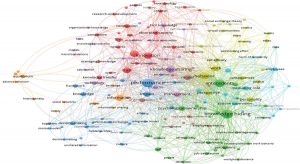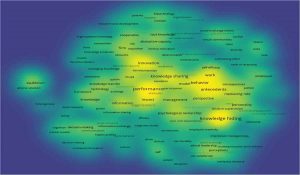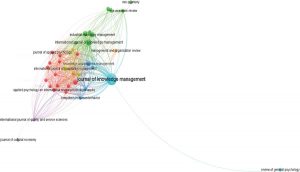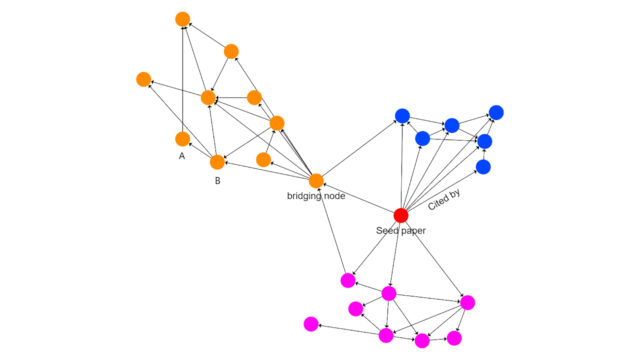
The past, present, and recommended future of knowledge hiding research
This article is part of a series on knowledge withholding, hiding, and hoarding.
With growing interest in knowledge hiding as a research topic, a newly published paper1 reports on a bibliometric review of 103 papers specifically discussing knowledge hiding and/or knowledge withholding in organisations.
Bibliometrics2 (also called scientometrics) provides a vital knowledge base for evidence-based decisions in regard to research priorities. In previous RealKM Magazine articles, I’ve featured two significant knowledge management (KM) studies that used bibliometrics / scientometrics. These were a 2018 study3 that evaluated KM as an academic discipline, and a recent study4 that looked at the implications for the KM discipline from a review of scientometric research.
Bibliometric analyses and visualisations
For their bibliometric review of knowledge hiding research, study authors Ivija Bernatović, Alenka Slavec Gomezel, and Matej Černe used three methods of bibliometric analysis – co-citation, co-word, and bibliographic coupling:
- Co-citation analysis uses citation tools to connect journals, authors, and various documents in order to ascertain the beginnings of a field and its whole structure.
- Co-word analysis searches for connections between concepts that co-occur in titles, abstracts, or keywords.
- Bibliographic coupling analysis shows the extent to which two articles reference the same articles.
As was done in the 2018 study5 that evaluated KM as an academic discipline, Bernatović, Slavec Gomezel, and Černe have used VOSviewer as an analysis and visualisation tool. Figures 1, 2, and 3 below show their resulting visualisations with the greatest relevance to KM practice.
Figure 1 visualises the results of the co-word analysis. The main idea behind co-word analysis is that words appearing often in documents might indicate related concepts. In this case, the analysis produced nine clusters with a total of 1,842 links. The strongest words in terms of number of links and total link strength were “knowledge hiding”, “performance”, and “antecedents”.

Figure 2 is related to Figure 1, with Figure 2 visualising the density of links strength for the clusters from Figure 1. The overall total link strength and most important occurrences are for the concepts of knowledge hiding, performance, antecedents, behaviour, and knowledge sharing. Two big circles were found for performance and innovation, and psychological concepts such as personality, perception, and territoriality also emerged.

Figure 3 visualises the results of the journals aspect of the bibliographic coupling analysis. It shows that the most relevant journal for knowledge hiding research (i.e., the one with the highest number of links and total link strength) is the Journal of Knowledge Management. This aligns with Implication #3 for KM practice from Alexander Serenko’s recent review6 of scientometric research of the KM discipline.

Conclusions and recommendations
Using the results of their bibliometric analyses, Bernatović, Slavec Gomezel, and Černe draw conclusions in regard to knowledge hiding research to date, and make recommendations to inform future research in the field. Their conclusions and recommendations are summarised below.
The past
- Origin and definition of knowledge hiding. The concept of “knowledge hiding” was first introduced in research published in 2012. This research also proposed the now widely accepted definition that “knowledge hiding is an intentional attempt by an individual to withhold or conceal knowledge that has been requested by another person.” However, prior to this conceptualisation, research had covered behaviours that could be characterised as knowledge hiding, captured by terms such as “hidden knowledge” or “hoarding (keeping) knowledge”. In fact, the notion that organisational members deliberately withhold knowledge had already drawn the attention of sociologists and anthropologists studying organisations over 50 years ago.
The present
- Current state of knowledge hiding research field. The concept of knowledge hiding has mostly been derived from the knowledge sharing literature and research on social psychology–reciprocity, social exchange, and dyads (in sociology, a dyad7 is a group of two people, the smallest possible social group). Despite these important contributions, there is still a lack of cross-level studies, multi-level studies, and investigations to examine the specific manifestations and driving forces of knowledge hiding at the individual, dyadic, and organisational levels.
- Psychology. Psychology theories were prevalent in the bibliometric review, with most scholars drawing on those theories to explain why and under what circumstances knowledge hiding occurs8. Psychological aspects of knowledge hiding highlighted in the review include territoriality and psychological ownership. Some clusters in this coupling covered vastly different fields and theoretical frameworks, referencing diverse literature ranging from psychology to sociology, strategic management, and industrial economics.
- Decision-making challenges. One challenging aspect of research on knowledge hiding is that it involves individual decisions, as well as decisions and factors at the organisational level.
- Performance and innovation. Even though performance and innovation emerged as important keywords, only a few articles were directly linked to the study of performance and innovation in the context of knowledge hiding.
- Geographic bias absent. No specific geographical area dominated the bibliometric review clusters, suggesting less “elitism” and less Western-school direction in the knowledge hiding field, as opposed to more established fields. This is possibly because the field is still in its development phase.
- Topics needing further development. Despite the breadth of existing research, the bibliometric review identified knowledge hiding research topics in need of further development. These include a more specific and nuanced assessment of how knowledge hiding affects work performance, and under which contextual conditions at different levels.
- Team dynamics. Team dynamics with regards to not only interpersonal relationships, but team composition, structure, and team-members’ networks of various nature developing over time are in dire need of further investigation, potentially through the application of social network perspectives.
- Conceptual clarity. An assessment of potential similarities and differences of knowledge hiding with similar or related constructs, such as employee silence and knowledge withholding, could provide an interesting evidence-based clarification of these concepts and how they relate. The bibliographic coupling analysis showed that knowledge withholding appeared to be a separate concept from knowledge hiding, as demonstrated by the disconnection of the two clusters. Some researchers have also investigated how knowledge hoarding and knowledge hiding are two distinct concepts of knowledge withholding, each with different antecedents and consequences for an organisation. However, other researchers have pointed out that little empirical research has been conducted on this distinction.
The recommended future
Based on the bibliometric review, several future directions for the knowledge hiding field are identified:
- Entrepreneurship. The clusters in the co-citation analysis presented an overview of the core theoretical backgrounds, ranging from psychology to strategic management and information technology. Notably, there was no connection with entrepreneurship, although concepts related to entrepreneurship, such as innovation and creativity, appeared in the majority of the clusters in the content analysis. In light of this, an interesting research question would be to investigate whether knowledge hiding differs among entrepreneurs, startups, venture capitalist, or other entities in the entrepreneurship field. Furthermore, evidence was found that knowledge sharing is important for entrepreneurs, small and medium enterprises (SMEs), and family firms. Therefore, it would be valuable to further explore any barriers to knowledge sharing and the motivations for knowledge hiding in these entrepreneurial settings. Building knowledge in this area would advance the theoretical perspective of knowledge hiding in the entrepreneurship context.
- Organisational relationships. In terms of organisation-level research, it would be interesting to see whether knowledge hiding is more prevalent in top-down relationships than in bottom-up or peer-to-peer relationships. If so, there could be a difference between levels of management (low, middle, or top management) in terms of knowledge hiding. Research at the organisational level considers the entire organisation, which is reflected through organisational culture, a known enabler of knowledge sharing. Yet, organisational culture could also provoke knowledge hiding. Therefore, investigating which management levels should pay closer attention to knowledge hiding could be advantageous for the KM field. Moreover, it could be beneficial to explore cross-level effects, the variables at different levels, and how managers interact with one another.
- Performance. Despite the importance of performance that emerged in the bibliometric analyses, very few articles pointed to performance as a measure for knowledge hiding. Because of the lack of literature on this topic, it is suggested that researchers should directly examine knowledge hiding and performance at the individual, team, and organisational levels using different dimensions and different facets of performance (in-role, extra-role; financial, non-financial, etc.). Further investigation is needed to determine whether and how employees use knowledge hiding to increase their performance. In addition, an interesting question is how companies measure success beyond performance and how that might be related to knowledge hiding.
- Psychology. As psychology was the most present theoretical background in the bibliometric analyses, the findings yielded suggestions for lines of inquiry related to psychology concepts and knowledge hiding. Scholars in some articles have used personality traits (optimistic and pessimistic) to identify and explain knowledge hiding. Therefore, it is proposed that future research should investigate whether and under what conditions knowledge hiding can be considered a positive or negative behaviour, with positive or negative intentions and consequences.
- Emotional intelligence. The concept of emotional intelligence is becoming an interesting topic for exploration. For example, one study tried to answer the question “are emotionally intelligent employees less likely to hide their knowledge?”, but suggested that this question needed further investigation. In the workplace cluster in the co-word analysis, the concept of workplace deviance was important. Another study discovered that knowledge hiding had a positive relationship with workplace deviance and suggested that researchers explore this concept further in the future. In organisational settings, it would be interesting to explore different employees’ backgrounds and whether their competencies influence knowledge hiding. It would also be fruitful to discover whether perceptions of work–life balance influence a person’s knowledge hiding practices and what other personal or organisational settings foster knowledge hiding.
- Ethical issues. Although one study explored the Islamic work ethic, ethical issues should be more present in the knowledge hiding literature given that knowledge hiding can introduce some negative ethical dynamics into the workplace. Organisations need to oversee and control ethical values/issues in the workplace, including those related to knowledge hiding.
Bernatović, Slavec Gomezel, and Černe conclude by saying that while the knowledge hiding field has grown considerably, interdisciplinary research is needed to more fully investigate the various concepts. They state that crucially, the knowledge hiding field needs a greater structure and focus to direct future research in this area.
Header image source: Review by Nick Youngson, Alpha Stock Images, CC BY-SA 3.0.
References and notes:
- Bernatović, I., Slavec Gomezel, A., & Černe, M. (2021). Mapping the knowledge-hiding field and its future prospects: a bibliometric co-citation, co-word, and coupling analysis. Knowledge Management Research & Practice, 1-16. ↩
- Pendlebury, D.A. (2010). White Paper: Using Bibliometrics in Evaluating Research. Philadelphia PA USA: Thomson Reuters. ↩
- Wang, P., Zhu, F. W., Song, H. Y., Hou, J. H., & Zhang, J. L. (2018). Visualizing the Academic Discipline of Knowledge Management. Sustainability, 10(3), 682. ↩
- Serenko, A. (2021). A structured literature review of scientometric research of the knowledge management discipline: a 2021 update. Journal of Knowledge Management. ↩
- Wang, P., Zhu, F. W., Song, H. Y., Hou, J. H., & Zhang, J. L. (2018). Visualizing the Academic Discipline of Knowledge Management. Sustainability, 10(3), 682. ↩
- Serenko, A. (2021). A structured literature review of scientometric research of the knowledge management discipline: a 2021 update. Journal of Knowledge Management. ↩
- Wikipedia, CC BY-SA 3.0. ↩
- See also The psychology behind knowledge hiding in organisations. ↩
Also published on Medium.






